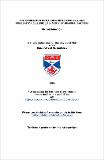Files in this item
The regulation of haemopoietic stem cell and progenitor cell proliferation by humoral factors
Item metadata
| dc.contributor.advisor | Riches, Andrew Clive | |
| dc.contributor.author | Cork, Michael John | |
| dc.coverage.spatial | 450 | en_US |
| dc.date.accessioned | 2012-06-11T10:49:43Z | |
| dc.date.available | 2012-06-11T10:49:43Z | |
| dc.date.issued | 1984 | |
| dc.identifier.uri | https://hdl.handle.net/10023/2720 | |
| dc.description.abstract | The mechanisms which regulate the growth fraction of the haemopoietic stem cell (CFU-S) and granulocyte macrophage progenitor cell (GM-CFC) have been investigated. In normal murine bone marrow (NMBM) a small proportion of the CFU-S are synthesising DNA (-10%). In contrast, in the bone marrow from mice regenerating after treatment with cytotoxic drugs and in developing haemopoietic tissues such as murine fetal liver a large proportion of the CFU-S (-40%) are synthesising DNA. Medium conditioned by normal murine and human bone marrow cells inhibited the proliferation of rapidly cycling CFU-S from regenerating bone marrow. This inhibitor was contained in a 50-100K daltons ultrafiltration fraction. In contra-distinction medium conditioned by human fetal liver cells stimulated the proliferation of CFU-S from NMBM. The stimulator was produced by adherent cells and was contained in a 30-50K daltons ultrafiltration fraction. An alternative assay for the humoral regulators of CFU-S proliferation was developed. Different numbers of haemopoietic cells were injected into lethally irradiated mice. Five days later they were injected with 2iCi of 125IUdR and sacrificed 2 hours later. There was a linear relationship between the log 125IUdR uptake into the spleen and femur and the log cell dose injected. Pre-treatment of haemopoietic cells with an S-phase specific cytotoxic drug resulted in a reduction in the 125IUdR incorporation into the spleen. This enabled the kinetic properties of a haemopoietic stem cell population to be assessed and the humoral 111 factors which modulate the growth fraction of these cells to be investigated. At early stages of gestation (11-14 weeks) in human fetal liver few GM-CFC are synthesising DNA, whereas later in gestation (>14 weeks) a large proportion of GM-CFC are in S-phase, Moore and Williams (1973b). Incubation of NMBM GM-CFC (approx 40% in DNA synthesis) with a supernatant from an early human fetal liver (11-14 weeks) reduced the proportion synthesising DNA to <5%. In contrast, the proportion of murine GM-CFC synthesising DNA was not affected by incubation with a supernatant from a late human fetal liver (>14 weeks). GM-CFC that had been switched out of cycle by incubation with a supernatant from an early gestation human fetal liver were switched back into cycle following incubation with a late human fetal liver supernatant. The inhibitor and stimulator of GM-CFC proliferation were both produced by non-adherent cells and were contained in >100K and 30-50K daltons ultrafiltration fractions repectively. It is likely that changes in the relative levels of a proliferation inhibitor and stimulator throughout gestation might control the proportion of GM-CFC in cycle. | en_US |
| dc.language.iso | en | en_US |
| dc.publisher | University of St Andrews | |
| dc.subject.lcc | QP92.C7 | en_US |
| dc.subject.lcsh | Hematopoietic stem cells | en_US |
| dc.subject.lcsh | Blood--Analysis | en_US |
| dc.title | The regulation of haemopoietic stem cell and progenitor cell proliferation by humoral factors | en_US |
| dc.type | Thesis | en_US |
| dc.type.qualificationlevel | Doctoral | en_US |
| dc.type.qualificationname | PhD Doctor of Philosophy | en_US |
| dc.publisher.institution | The University of St Andrews | en_US |
This item appears in the following Collection(s)
Items in the St Andrews Research Repository are protected by copyright, with all rights reserved, unless otherwise indicated.

